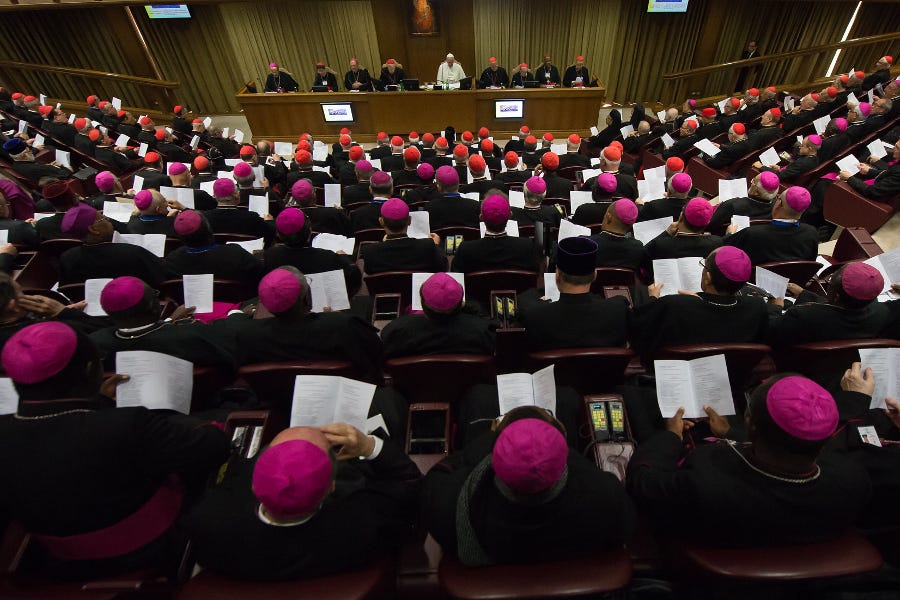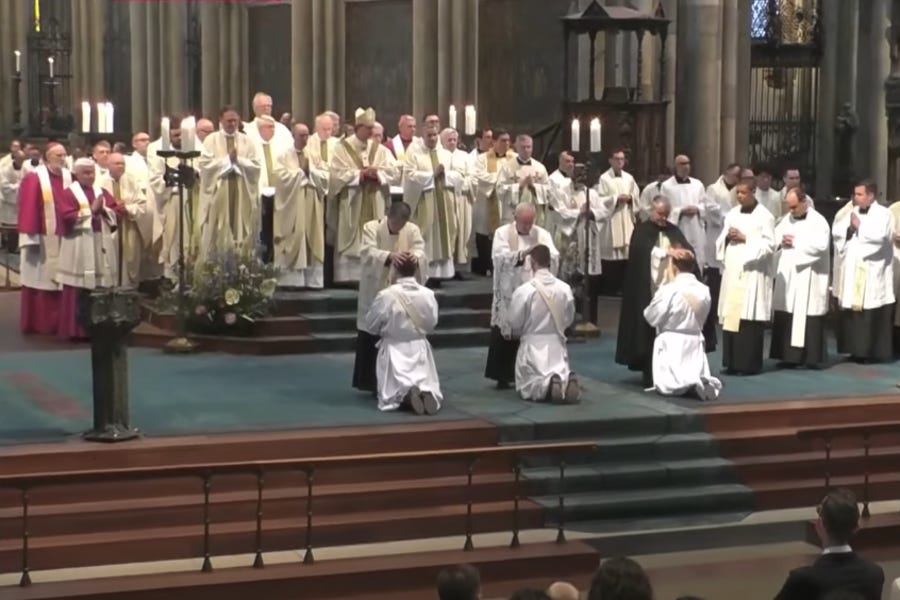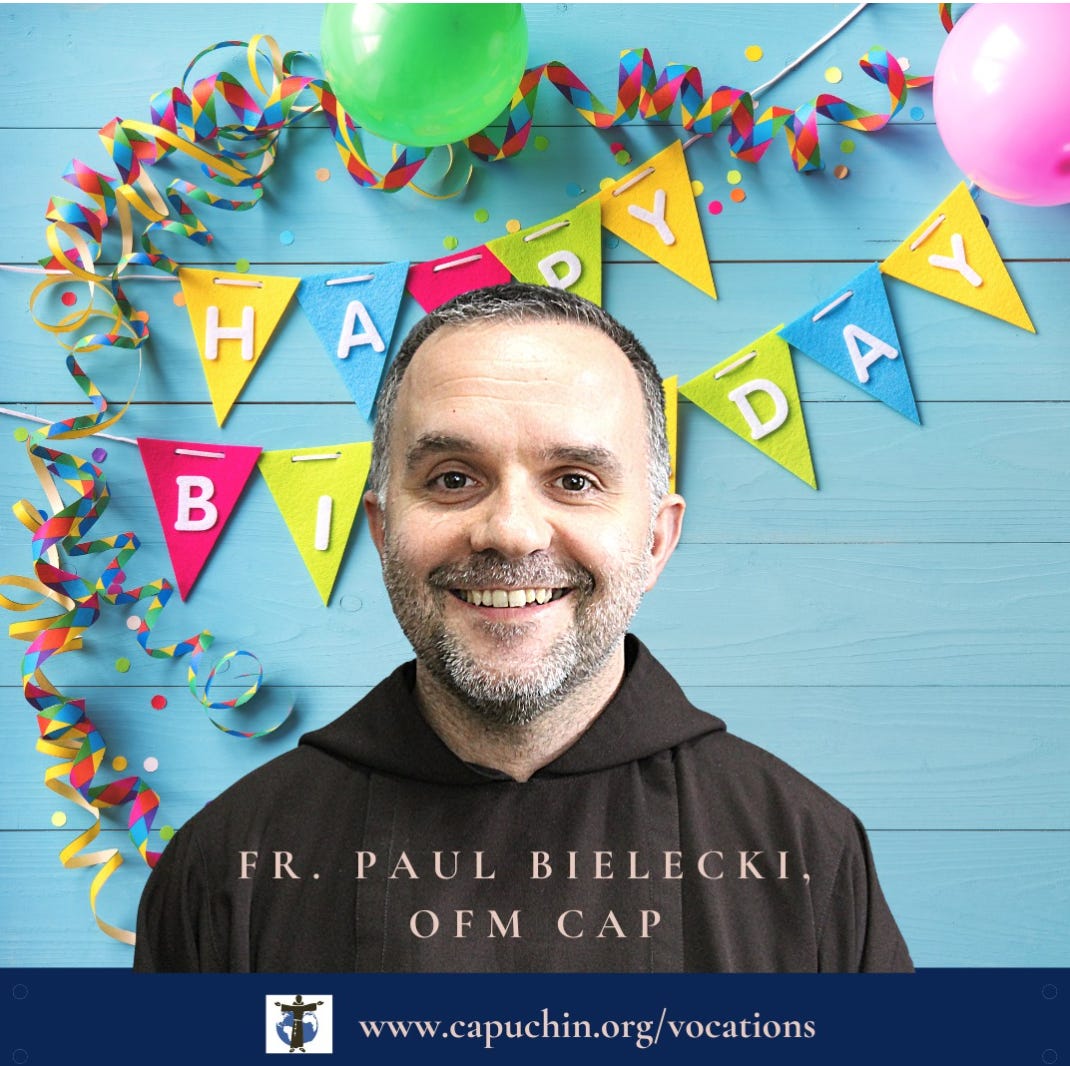Broader participation in the decision-making processes of the Church is a prominent theme of the working document for the first global session on the Synod on Synodality, which was officially released Tuesday by the Vatican.
The document will form the basis of discussion at the first gathering of the universal phase of the Synod on Synodality, to be held in Rome this October.
The text presents a series of discernment questions, covering topics including the role of women in the Church, how to preach the Gospel more effectively on digital platforms, and how the Church can better welcome people with disabilities.
The relationship between the synodal and hierarchical natures of the Church are also explored in the document, which asks how bishops can involve more people in their decision-making processes, and how the exercise of the pope’s primacy should “evolve” to make the Church more synodal.
The working document - formally known as an Instrumentum laboris - identifies three central priorities for the upcoming synod gathering in Rome this October: communion, mission, and participation.
Each of these themes was raised in the Continental Assemblies on which the working document is based. The continental gatherings, in turn, drew from summaries of diocesan listening sessions during the first part of the multi-year synod process.
Typically, the Instrumentum laboris serves as a sort of first draft for the synod gathering, which is edited and adapted to create a final document that is presented to the pope at the end of the synod.
In this case, however, the document presents worksheets with questions for discernment, reflection and discussion by the Synodal Assembly.
In its introduction, the Instrumentum laboris states that the listening phase of the synod process has already borne fruit.
“[W]e have experienced the joy expressed in the sincere and respectful encounter between brothers and sisters in the faith: to meet each other is to encounter the Lord who is in our midst,” it says.
The document also acknowledges tensions in the synodal process, saying, “We should not be frightened by them, nor attempt at any cost to resolve them, but rather engage in ongoing synodal discernment. Only in this way can these tensions become sources of energy and not lapse into destructive polarizations.”
The goal of synodality, the document says, is to create “a Church of sisters and brothers in Christ who listen to one another and who, in so doing, are gradually transformed by the Spirit.”
A synodal Church, it says, is one marked by a willingness to listen, encounter, and dialogue, as well as by the humility to ask forgiveness for faults. It is a Church that celebrates unity in diversity and welcomes all people, while not shying away from speaking the truth in love.
The document acknowledges that “Some of the questions that emerged from the consultation of the People of God concern issues on which there is already magisterial and theological teaching to be considered.” It points to remarried divorcees and inculturation of liturgy as examples.
“The fact that questions continue to emerge on issues like these should not be hastily dismissed, rather, it calls for discernment, and the Synodal Assembly is a privileged forum for so doing,” the document continues. “In particular, the obstacles, real or perceived, that have prevented the steps indicated by previous documents from being realised should be considered and reflections offered on how they can be removed.”
“For example, if the block stems from a general lack of information, then improved communication will be needed. If, on the other hand, the problem stems from the difficulty of grasping the implications of the documents in ordinary situations or an inability of persons to recognise themselves in what is proposed, a synodal journey of effective reception by the People of God could be the appropriate response. Another instance could be the reappearance of a question which emerges as a sign of a changed reality or situations where there is a need for an ‘overflow’ of Grace. This requires further reflection on the Deposit of Faith and the living Tradition of the Church.”
–
The first set of worksheets centers on the question, “A communion that radiates: How can we be more fully a sign and instrument of union with God and of the union of all humanity?”
It invites synod participants to reflect on how the Church can welcome migrants, include the elderly and people with disabilities, and overcome political polarization in society.
“How can we create spaces where those who feel hurt by the Church and unwelcomed by the community feel recognized, received, free to ask questions and not judged?” it asks. “In the light of the Post-Synodal Apostolic Exhortation Amoris Laetitia, what concrete steps are needed to welcome those who feel excluded from the Church because of their status or sexuality (for example, remarried divorcees, people in polygamous marriages, LGBTQ+ people, etc.)?”
Other topics raised in the communion section are ecumenism and the Church’s relationship with a secular society.
“How can the Church remain in dialogue with the world without becoming worldly?” the working document asks.
It also notes that in the earlier stages of the synod, it became clear that non-Latin and non-Western Churches wanted to have their traditions recognized and their voices heard.
“How can each local Church, the subject of mission in its context, enhance, promote and integrate the exchange of gifts with the other local Churches within the horizon of the one Catholic Church?” it asks.
–
The next set of worksheets looks at the theme, “Co-responsibility in Mission: How can we better share gifts and tasks in the service of the Gospel?”
Synod participants are invited to reflect on topics including how the Church can be more effective at proclaiming the Gospel and accompanying people in the digital environment.
The worksheets also explore the role of women in the Church. The Continental Assemblies encouraged that attention be given to women’s status and experience within the Church, while also noting the diversity in women’s experiences and perspectives, the document says.
The listening sessions also indicated “the desire for a greater presence of women in positions of responsibility and governance,” it adds.
It encourages participants to reflect on ways to recognize and support the existing contribution of women in the Church, as well as ministries to allow women to play a greater role in discernment and decision-making.
“Most of the Continental Assemblies and the syntheses of several Episcopal Conferences call for the question of women’s inclusion in the diaconate to be considered. Is it possible to envisage this, and in what way?” the document questions.
Other topics that were raised in listening sessions include a need to overcome clericalism and the importance of recognizing the complementary and inter-related nature of ordained ministry and baptism ministries.
The Continental Assemblies displayed “a clear call to overcome a vision that reserves any active function in the Church to ordained Ministers alone (Bishops, Priests, Deacons), reducing the participation of the Baptised to a subordinated collaboration,” it says.
The relationship between the sensus fidei and the bishop’s magisterial authority is also a subject of significant discussion in the document.
“Should Bishops discern together with or separately from the other members of the People of God? Do both options (together and separately) have a place in a synodal Church?” it asks.
“When might a Bishop feel obliged to take a decision that differs from the considered advice offered by the consultative bodies? What would be the basis for such a decision?” it questions.
The document says that listening sessions have highlighted “how becoming a more synodal Church also implies a broader involvement of all in discernment, which requires a rethinking of decision-making processes. Consequently, there is need for adequate governance structures which respond to the demand for greater transparency and accountability, which will impact the way the Bishop's ministry is exercised.”
“This has also brought to the fore resistance, fear and a sense of disorientation. In particular, while some call for greater involvement of all the Faithful and thus a ‘less exclusive’ exercise of the Bishops' role, others have expressed doubts and fear the risk of drift if left to the processes of political democracy,” it says.
“There is an equally strong awareness that all authority in the Church proceeds from Christ and is guided by the Holy Spirit. A diversity of charisms without authority becomes anarchy, just as the rigour of authority without the richness of charisms, ministries and vocations becomes dictatorship,” the working document continues.
“The Church is, at the same time, synodal and hierarchical, which is why a synodal exercise of episcopal authority suggests one that accompanies and safeguards unity. Episcopal ministry is properly reconceived and realised through the practice of synodality, which brings into unity the diverse gifts, charisms, ministries and vocations to which the Spirit gives rise in the Church.”
The document asks, “Can Lay people perform the role of community leaders, particularly in places where the number of ordained Ministers is very low? What implications does this have for the understanding of ordained Ministry?”
It also raises the question of allowing married men to be ordained priests, and of allowing for broader participation in the process of selecting bishops.
The role of the pope is also raised in the working document, which poses the question, “How should the role of the Bishop of Rome and the exercise of his primacy evolve in a synodal Church?”
–
The final section of the Instrumentum laboris is entitled, “Participation, governance and authority: What processes, structures and institutions are needed in a missionary synodal Church?”
The section asks synod participants to reflect on how to foster the participation of marginalized voices in decision-making processes.
“How can we imagine decision-making processes that are more participatory, which give space for listening and community discernment supported by authority understood as a service of unity?” it asks.
It also calls on synod participants to consider how to respond constructively in cases where the ultimate decision maker does not agree with the decisions reached by a community discernment process.
The participation section of the document questions ways to think about institutions within the Church, suggesting that canon law may need to be changed to renew the Church’s structures and institutions.
“What degree of doctrinal authority can be attributed to the discernment of Episcopcal Conferences?” it asks.
It also asks how a “synodal perspective” can help create a culture that prevents abuse.
Despite the reflections on Church institutions, the Instrumentum laboris emphasizes that structural changes are not a substitute for a change in culture within the Church.
“Institutions and structures alone are not enough to make the Church synodal,” it says. “A synodal culture and spirituality are needed animated by a desire for conversion and sustained by adequate formation.”




